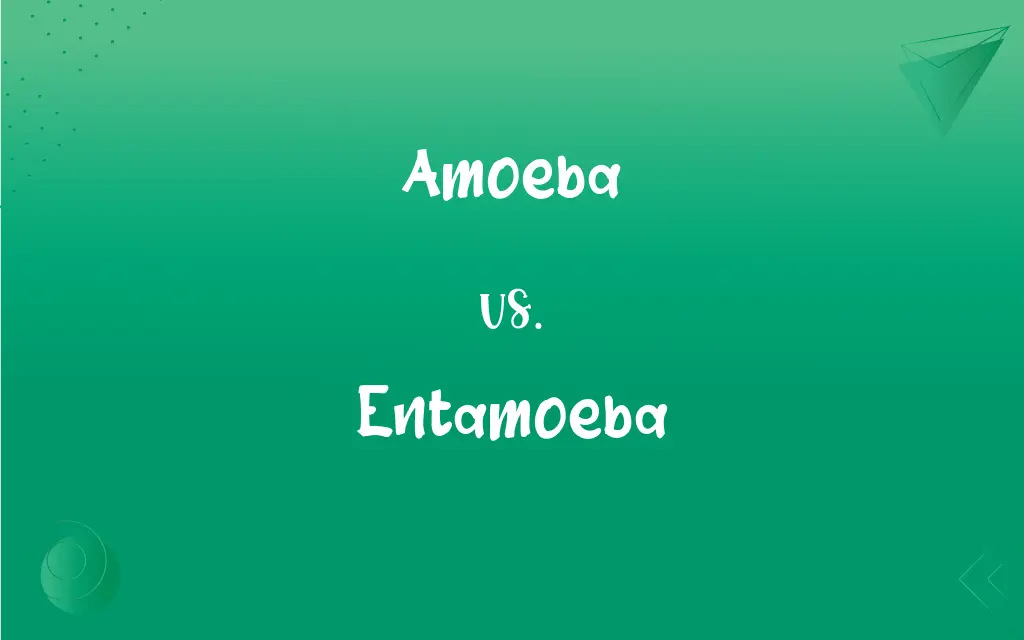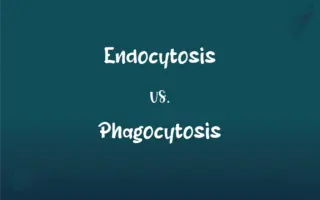Amoeba vs. Entamoeba: What's the Difference?
Edited by Aimie Carlson || By Harlon Moss || Published on January 23, 2024
Amoeba is a genus of single-celled organisms in diverse environments; Entamoeba is a specific genus of amoebas, some species of which are pathogenic.

Key Differences
Amoeba refers to a broad genus of single-celled microorganisms characterized by their shape-shifting abilities. They are commonly found in freshwater, soil, and marine environments. Entamoeba, on the other hand, is a specific genus within the amoeba group, known primarily for certain species that are pathogenic to humans.
The typical amoeba is known for its ability to change shape and move via pseudopodia, or "false feet." They are often studied in biology for their simple structure and movement. Entamoeba, while sharing these basic amoebic characteristics, is particularly noted for species like Entamoeba histolytica, which causes the disease amoebiasis in humans.
Amoebas, in general, play diverse roles in their ecosystems, often acting as decomposers. They are a key part of the microbial environment and have various species with different characteristics. Entamoeba species are mostly parasitic, living in the intestines of various animals, including humans, and can cause significant health issues.
Most amoebas are harmless and play beneficial ecological roles, while Entamoeba’s pathogenic species pose a health threat, causing symptoms like diarrhea and stomach pain in infected individuals. This distinction is crucial in medical and environmental studies.
All Entamoeba are amoebas, not all amoebas are Entamoeba. The general amoeba genus includes a wide variety of species with different lifestyles and habitats, whereas the Entamoeba genus is specifically known for its pathogenic species affecting human health.
ADVERTISEMENT
Comparison Chart
General Description
A genus of shape-shifting, single-celled organisms
A specific genus within amoebas, some species are pathogenic
Habitat
Freshwater, soil, marine environments
Primarily parasitic in animal intestines
Role in Environment
Decomposers, part of microbial ecology
Mostly parasitic, can cause diseases in hosts
Pathogenicity
Mostly harmless, ecological role
Includes species harmful to humans like E. histolytica
Study Focus
Studied for basic cell biology and movement
Studied for its impact on human health and disease
ADVERTISEMENT
Amoeba and Entamoeba Definitions
Amoeba
Amoebas are mostly found in freshwater and soil.
We observed amoebas under the microscope in pond water.
Entamoeba
Entamoeba is a genus of amoebas, some of which are pathogenic.
Entamoeba histolytica is known to cause amoebiasis.
Amoeba
They play a role as decomposers in the ecosystem.
Amoebas contribute to breaking down organic material in their habitat.
Entamoeba
Entamoeba species primarily live as parasites in animal intestines.
Entamoeba species are studied for their parasitic lifestyle.
Amoeba
Amoebas move and feed by extending their pseudopodia.
The amoeba engulfed its food using its pseudopodia.
Entamoeba
They are significant in medical research due to their impact on health.
Research on Entamoeba focuses on treatment for amoebiasis.
Amoeba
An amoeba is a single-celled organism capable of changing shape.
The amoeba moved by extending its pseudopodia.
Entamoeba
Entamoeba is typically diagnosed through stool samples.
Doctors detected Entamoeba in the patient's laboratory tests.
Amoeba
These organisms are key to understanding basic cell functions.
Amoebas are used in schools to teach about cell biology.
Entamoeba
Entamoeba histolytica can cause severe intestinal diseases.
Entamoeba infections can lead to dysentery in humans.
Amoeba
Any of various one-celled free-living or parasitic protozoans having no definite form and moving by means of pseudopods.
Entamoeba
Any of several parasitic amoebas of the genus Entamoeba, especially E. histolytica, causing dysentery and ulceration of the colon and liver.
Amoeba
(biology) A member of the genus Amoeba of unicellular protozoa that moves by means of temporary projections called pseudopodia.
Entamoeba
Alternative spelling of entameba
FAQs
Where can amoebas be found?
In diverse environments like freshwater, soil, and marine areas.
What is an amoeba?
A single-celled organism known for its shape-shifting ability.
How do amoebas move?
By extending and retracting their pseudopodia.
Are all Entamoeba species harmful?
No, but some, like E. histolytica, are pathogenic.
How is Entamoeba transmitted?
Often through contaminated food or water.
What diseases can Entamoeba cause?
Diseases like amoebiasis, especially caused by E. histolytica.
How is an Entamoeba infection diagnosed?
Usually through stool tests.
Do amoebas have complex cellular structures?
They have simple structures typical of single-celled organisms.
Can Entamoeba infections be treated?
Yes, typically with specific antiparasitic medications.
What is Entamoeba?
A genus of amoebas, some species of which are pathogenic.
What ecological role do amoebas play?
They act as decomposers in many ecosystems.
Where does Entamoeba histolytica live in the human body?
In the large intestine.
Can amoebas infect humans?
Most are harmless, but some, like certain Entamoeba species, can cause infections.
Can amoebas be seen with the naked eye?
No, they are microscopic.
Are amoebas used in educational settings?
Yes, they're often used to teach basic cell biology.
Do amoebas reproduce sexually or asexually?
Most reproduce asexually through binary fission.
Are there vaccines for Entamoeba infections?
No, there are currently no vaccines for these infections.
What are common symptoms of Entamoeba infection?
Diarrhea, stomach pain, and sometimes dysentery.
What is the size of an amoeba?
They are usually a few micrometers in length.
Is it easy to eliminate Entamoeba from an environment?
It requires good hygiene and sanitation practices.
About Author
Written by
Harlon MossHarlon is a seasoned quality moderator and accomplished content writer for Difference Wiki. An alumnus of the prestigious University of California, he earned his degree in Computer Science. Leveraging his academic background, Harlon brings a meticulous and informed perspective to his work, ensuring content accuracy and excellence.
Edited by
Aimie CarlsonAimie Carlson, holding a master's degree in English literature, is a fervent English language enthusiast. She lends her writing talents to Difference Wiki, a prominent website that specializes in comparisons, offering readers insightful analyses that both captivate and inform.































































